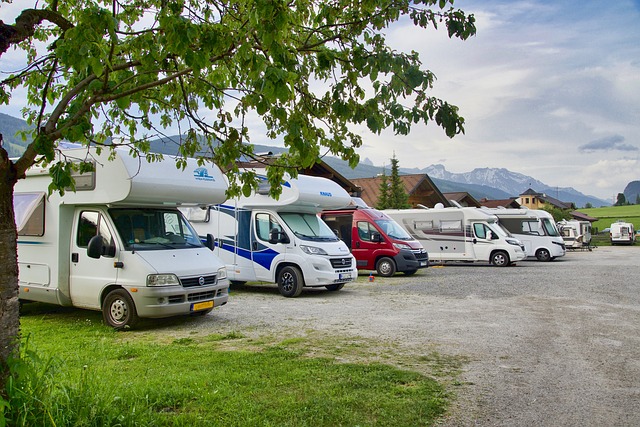When managing an RV battery system, safety and knowledge are paramount. RV owners must choose between lead-acid batteries, known for their reliability but requiring careful handling of corrosive electrolytes, or lithium batteries, which offer longer life spans and higher energy density but need strict adherence to safety protocols. Regular state of charge monitoring and the use of protection circuits to prevent over-discharge are essential for maintaining lithium battery health. Proper charging methods, ventilation during charging, and following manufacturer guidelines are critical to ensure safety and longevity of any RV battery system. Routine maintenance, including checking the battery's state of charge, terminals, and connections, is necessary to prevent issues like overcharging or deep discharge. Selection of an appropriately sized RV battery that matches your energy needs is crucial for functionality and to avoid potential electrical failures. In case of malfunction, immediate action must be taken to disconnect the battery, clean up any spills safely, and follow the manufacturer's instructions. Always ensure proper disposal of old batteries at certified facilities to protect the environment. An emergency kit with safety gear should be on hand for addressing any incidents involving RV batteries, including potential fires, which can be mitigated by using a class ABC or CO2 fire extinguisher. Regular maintenance checks are vital to prevent emergencies and ensure a reliable power source for your RV adventures.
When embarking on RV adventures, safety should be at the forefront, particularly concerning your RV’s battery system. This article outlines critical hazards associated with RV batteries and strategies to mitigate risks. We’ll explore various RV battery types, their inherent dangers, and the importance of proper maintenance. Key topics include preventing deep discharge, avoiding overcharging, ensuring ventilation against gas accumulation, and selecting compatible batteries for your system. Additionally, we’ll address safe disposal and recycling practices for old batteries and what steps to take in case of a battery malfunction. Stay informed and stay safe with these essential RV battery guidelines.
- Understanding RV Battery Types and Their Risks
- The Dangers of Deep Discharge and Overcharging
- Proper Ventilation: Preventing Gas Accumulation Around Your RV Batteries
- Regular Maintenance: The Key to Avoiding Battery Failure
- The Importance of Compatibility: Choosing the Right Battery for Your RV System
- Safe Disposal and Recycling of Old RV Batteries
- Emergency Protocols: What to Do in Case of RV Battery Malfunction
Understanding RV Battery Types and Their Risks

When it comes to RV battery safety, knowledge is paramount. There are various types of batteries used in recreational vehicles, each with its own set of risks and maintenance requirements. Lead-acid batteries were traditionally the most common, offering a reliable energy source but requiring careful handling due to their corrosive electrolyte solution. They also have a shorter lifespan compared to newer technologies and are heavier, which can be a consideration for RVers looking to optimize their vehicle’s weight distribution.
Lithium batteries have emerged as a popular alternative, providing lighter weight, longer life cycles, and higher energy density. However, they come with their own set of safety concerns; improper charging can lead to overheating or even fire hazards. It’s crucial for RV owners to understand the correct charging procedures and to monitor the state of charge regularly to avoid these risks. Additionally, lithium batteries require protection circuits to manage over-discharge prevention, which is essential to maintain their health and longevity. Understanding the nuances between these battery types and implementing proper care and maintenance can significantly enhance both the safety and reliability of your RV’s power system. Always refer to the manufacturer’s guidelines for safe operation and consider professional advice when installing or managing new battery systems in your RV.
The Dangers of Deep Discharge and Overcharging

When traveling in an RV, maintaining the health and safety of your RV batteries is paramount. Two common hazards that can compromise your batteries are deep discharge and overcharging. Deep discharge occurs when the battery is drained to a point where it cannot hold a charge properly; this depletes the battery’s capacity and can lead to permanent damage or even cause the battery to fail. To prevent deep discharge, it’s crucial to monitor the battery’s state of charge and avoid using electronics that draw power continuously when the RV is not in use. Additionally, ensure your charging system is set up correctly to avoid overcharging, which can overheat the battery and cause chemical damage leading to a shorter lifespan or even explosion. Regularly checking the voltage and monitoring the battery’s temperature during charging can help prevent overcharging incidents. RV battery maintenance involves careful attention to these factors to ensure a safe and reliable power source throughout your travels. Always refer to the manufacturer’s guidelines for optimal charging voltages and recommended practices to safeguard your RV batteries against deep discharge and overcharging.
Proper Ventilation: Preventing Gas Accumulation Around Your RV Batteries

When managing your RV batteries, ensuring proper ventilation is paramount to prevent gas accumulation, which can be hazardous. Batteries, particularly lead-acid types, release hydrogen gas during the charging process. This gas, if allowed to accumulate without adequate ventilation, can pose a significant explosion risk. To mitigate this danger, always charge your RV batteries in a well-ventilated area or use a battery charger that is designed for use within an enclosed space and equipped with proper safety features to manage the release of gases. Additionally, regular maintenance checks should include inspecting the ventilation caps to ensure they are not damaged or cracked, as these caps are responsible for releasing built-up gases safely. By prioritizing ventilation and being vigilant about the condition of your batteries and chargers, you can significantly reduce the risk of accidental fire or explosion related to RV battery charging. It’s also advisable to follow the manufacturer’s instructions for both charging and maintenance procedures to further enhance safety. Remember, the key to safe RV battery operation is a combination of using the right equipment in suitable conditions and maintaining a consistent awareness of the batteries’ environmental impact.
Regular Maintenance: The Key to Avoiding Battery Failure

Regular maintenance is a cornerstone in the longevity and reliability of your RV’s batteries, playing a pivotal role in preventing failure. To maintain your RV battery’s optimal performance, it’s crucial to monitor its charge levels regularly. Consistent monitoring helps prevent overcharging or deep discharge conditions that can permanently impair the battery’s capacity. Performing routine inspections of the battery terminals and connections is also vital, as loose or corroded terminals can lead to poor electrical contact, causing inefficiencies and potentially shortening the lifespan of the battery.
Furthermore, keeping the battery clean and free from dirt and debris is essential for its functioning. The electrolyte solution within the battery should be at the correct specific gravity level, which can be checked with a hydrometer. Regularly topping off the distilled water in lead-acid batteries ensures that the plates remain fully submerged, allowing for consistent charge acceptance and cycle life. In addition to these practices, storing your RV battery properly when not in use is imperative to prevent self-discharge or damage from extreme temperatures. By adhering to a regular maintenance schedule, you can significantly reduce the risks associated with battery malfunction and ensure that your RV journeys remain uninterrupted by power issues.
The Importance of Compatibility: Choosing the Right Battery for Your RV System

When it comes to maintaining the safety and functionality of your Recreational Vehicle (RV), understanding the importance of compatibility between your RV battery and its system is paramount. The right battery not only ensures optimal performance but also extends the lifespan of your RV’s electrical components and can prevent potential hazards. RV batteries, particularly lead-acid or deep-cycle types, are designed to handle the unique demands of an RV, such as powering lights, appliances, and electronics. Incorrect battery selection can lead to issues like insufficient power supply, reduced efficiency, and even damage to your RV’s electrical system. It’s crucial to select a battery with the right capacity, voltage, and amp-hour rating for your RV’s specific needs. For instance, a battery that is too small might fail to start your RV or run essential systems during an off-grid adventure, while one that’s too large may not fit properly or could be a waste of resources. To avoid these pitfalls, carefully assess your RV’s power requirements and consult with experts or refer to manufacturer specifications when choosing an RV battery. Proper compatibility ensures safe operation and peace of mind, allowing you to enjoy your RV travels without the worry of unexpected electrical failures. Always prioritize the right rv battery for a smooth and secure RV experience.
Safe Disposal and Recycling of Old RV Batteries

When the time comes to replace your RV battery, it’s crucial to handle the disposal and recycling process responsibly. Old RV batteries contain hazardous materials such as lead, sulfuric acid, and heavy metals that can cause environmental harm if not disposed of properly. To ensure these materials are reclaimed and repurified, it’s essential to take your used battery to a certified recycling center. These facilities are equipped to safely disassemble the battery, separate its components, and recycle the materials for use in new products. This not only mitigates ecological damage but also conserves valuable resources. Always check local regulations as some regions have specific rules regarding battery disposal. By taking this proactive step, RV owners can contribute to a greener planet while avoiding the potential health risks associated with improper battery disposal. Remember to never attempt to break down or dispose of an RV battery on your own, as this can be hazardous and illegal. Opt for professional recycling services to manage your old RV batteries responsibly.
Emergency Protocols: What to Do in Case of RV Battery Malfunction

When faced with an RV battery malfunction, prompt and precise action is critical to ensure safety and minimize potential damage. In the event of a short circuit or overcharging, immediately disconnect the battery from any power sources and remove all electrical devices connected to it. This will prevent further current flow and protect your RV’s electrical system from potential harm. Ensure that you have a well-prepared emergency kit readily accessible, which includes safety glasses, gloves, and insulating materials like wood or plastic blocks to insulate the battery terminals if they are exposed.
If an spill occurs, carefully clean the electrolyte using distilled water and absorbent materials like baking soda or sand. Do not use substances that may generate a spark or heat, as these could ignite the flammable electrolyte solution. Once the immediate threat is contained, ventilate the area to avoid inhaling harmful fumes and assess whether the battery can be safely recharged or if it needs replacement. Always refer to the manufacturer’s guidelines for specific protocols related to your RV battery type. Additionally, familiarize yourself with the location of the fire extinguisher on board and understand its proper use, especially for battery fires, which should be extinguished using a class ABC or CO2 fire extinguisher. Proactive measures such as regular maintenance checks can prevent many malfunctions; therefore, regularly inspect your RV battery connections, voltage levels, and overall condition to avoid emergencies.
When journeying in an RV, safety should always be a top priority, especially concerning your RV batteries. This article has highlighted critical aspects of RV battery management, from selecting the appropriate battery type to understanding the risks associated with each. It’s crucial to avoid deep discharge and overcharging, which can impair battery performance or lead to failure. Ensuring proper ventilation is key to preventing hazardous gas accumulation, and regular maintenance extends your RV battery’s lifespan. Additionally, it’s imperative to consider compatibility when selecting a battery for your RV system to maintain optimal function. Should an issue arise, having a clear emergency protocol in place can mitigate potential dangers. Remember to dispose of or recycle old batteries properly to uphold safety and environmental standards. By adhering to these guidelines, RVers can enjoy their adventures with the assurance that their batteries are operated safely and efficiently.
